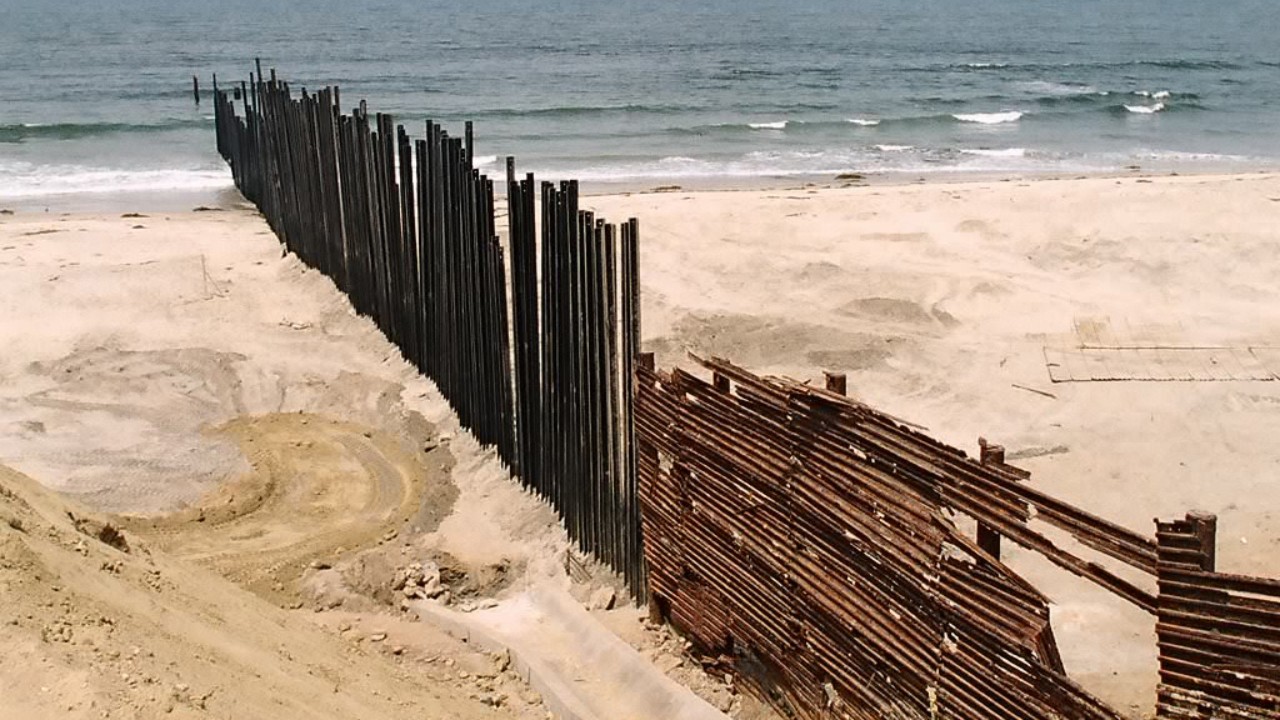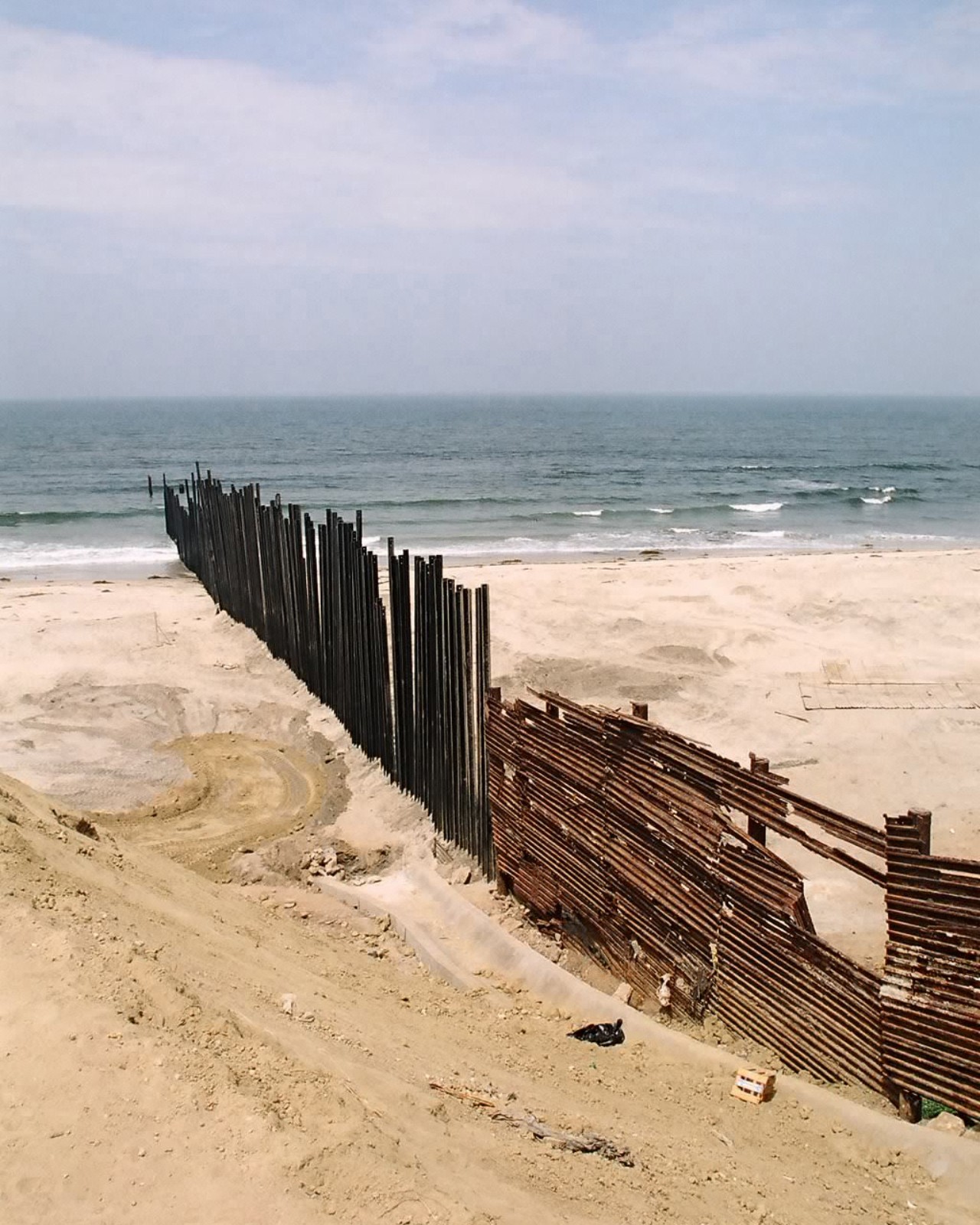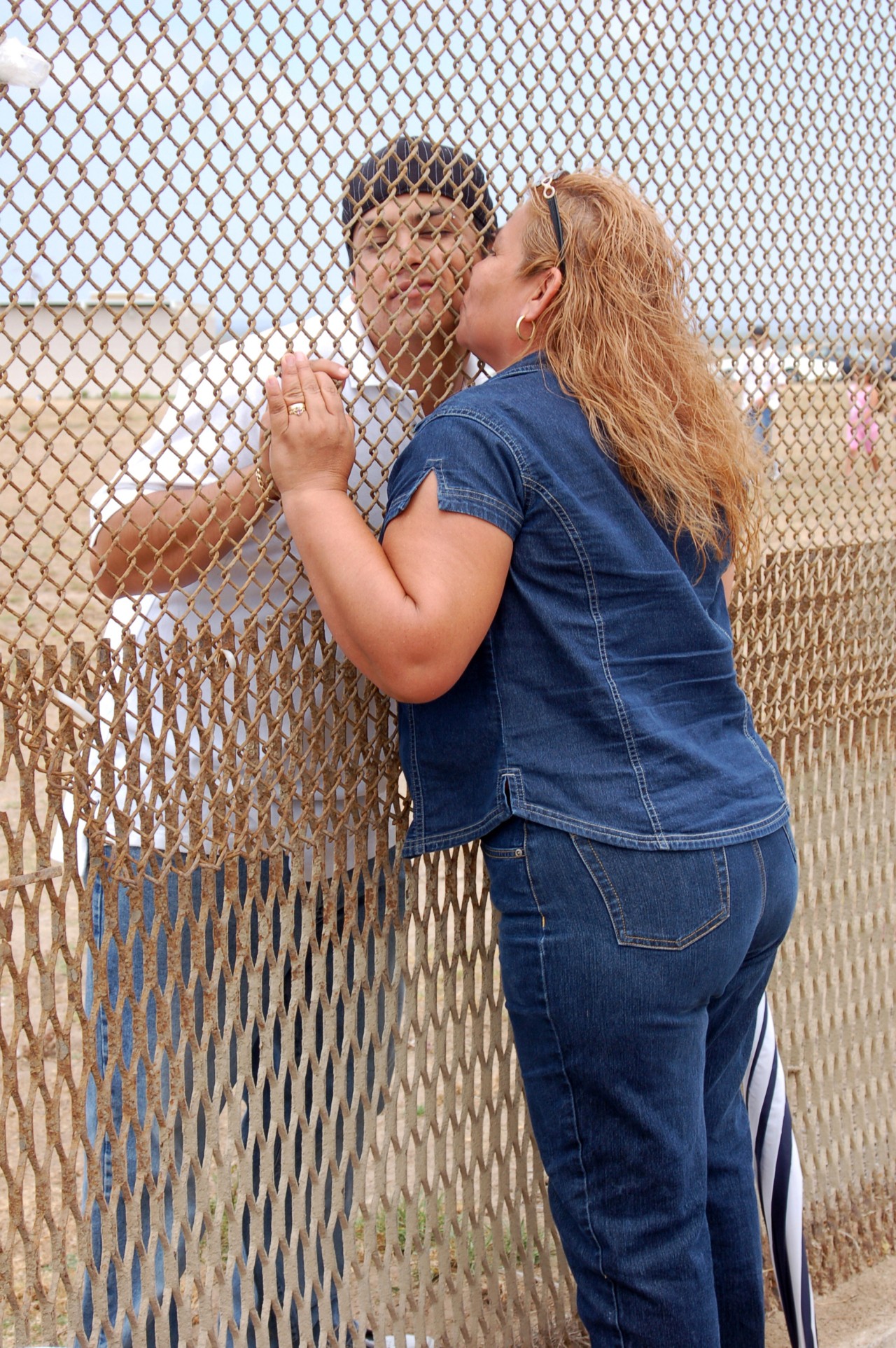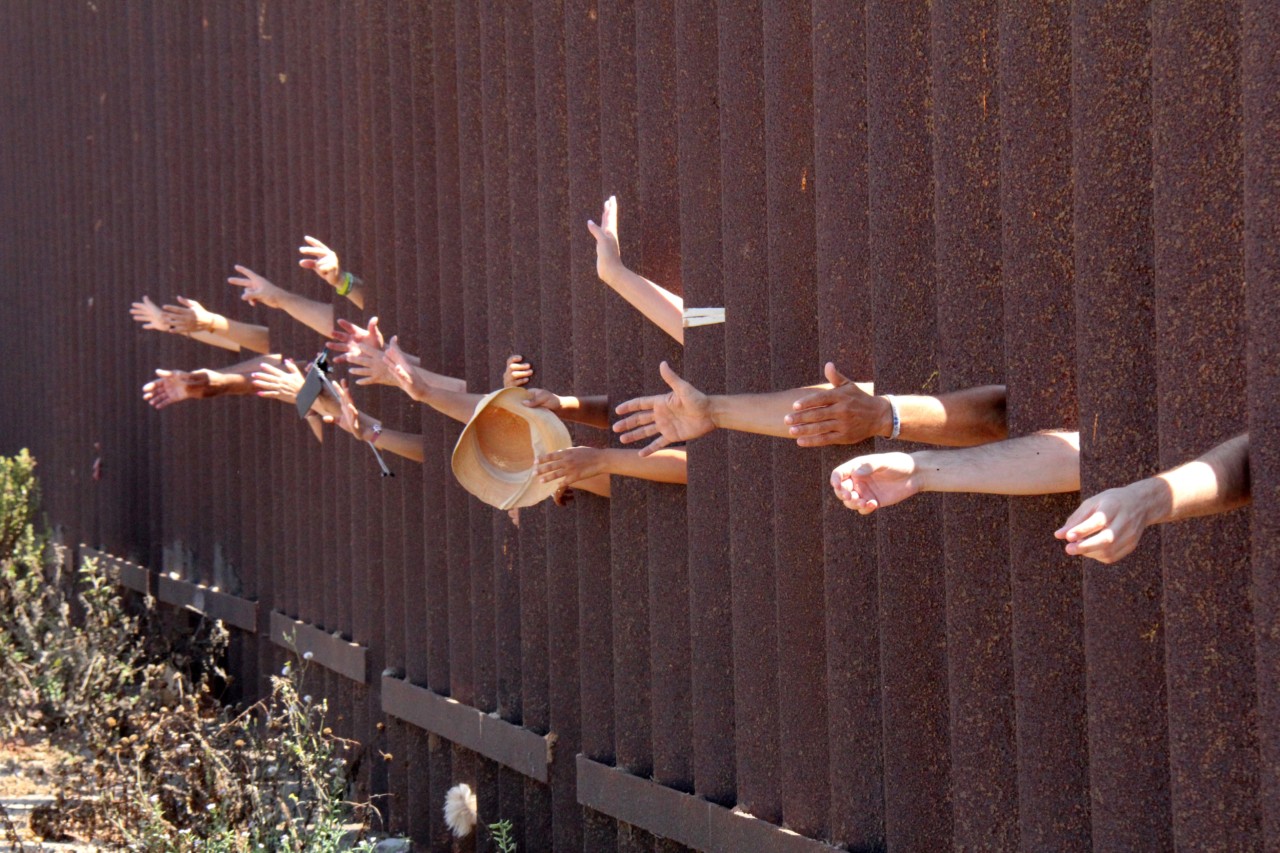

WORDS BY YESSENIA FUNES
Photographs by María Teresa Fernández
In 2000, only a row of rusted steel poles with metal sheets and a mesh fence separated Tijuana, Mexico, from San Diego, California. It was in those days that María Teresa Fernández began to photograph Friendship Park, a binational space that sits between the two cities along the Pacific Ocean. Friendship Park served as a meeting area, a sacred ground where immigration status didn’t matter. Fernández captured precious moments during her visits: a lover’s embrace, a daughter’s heartbreak, a mother’s devotion.
“Some days, kids and couples would cross the beach into the American side to be together for the day,” she said in Spanish, smiling, her gray hair neatly pulled into a bun. Fernández is dressed plainly—a black sweater over a white polo shirt with black pants and single pearl earrings—as she points to her photos. They reveal the history of Friendship Park. Over two decades, the United States government slowly added taller and thicker walls along the border, the gaps between the poles narrowing, disrupting the fluidity that once made the park so special.
The 72-year-old’s artwork hung as part of a Friendship Park exhibition in the Bonita Museum and Cultural Center, some 8 miles outside San Diego. The exhibit opened in February to mark five years since the U.S. government closed its side of the park. Loved ones can no longer hold hands through the openings. Families remain indefinitely separated.
When I visited the park in March, I tried to imagine the past, but the 30-foot-high walls were too distracting. Instead, I considered the future: the day these walls fall. That’s the vision of Friends of Friendship Park, the organization that nurtures the land with native flowers, food, and political art. It’s a far cry from the more than $60 billion President Donald Trump is investing to militarize the border with the “One Big Beautiful Bill Act” he signed on the Fourth of July, but the community won’t relent. On August 16, they celebrated a Day of International Friendship with art on both sides of the wall. On the Mexican side, organizers flew a condor puppet; on the U.S. side, a bald eagle.
They also brought out an art piece displayed at the exhibition earlier this year: a red heart banner painted by LGBTQIA+ migrants at Caza de Luz, a home for queer asylum seekers and migrants in Tijuana. The wall-sized heart read: “MIGRATION IS NATURAL. MIGRAR ES NATURAL.”

Friendship Park’s origins can be traced to 1971, when California bought the land from the federal government to establish Border Field State Park. Republican First Lady Pat Nixon visited the area, exclaiming, “I hate to see a fence anywhere,” as she asked her security to cut the barbed wire separating the U.S. from Mexico to join the people on the other side.
That attitude slowly faded around 1994, when Border Patrol launched Operation Gatekeeper to militarize the southern border. The San Diego border had become a popular crossing location for migrants headed north, so the U.S. government added more officers and steel rods. Then, in 2001, came 9/11.
“9/11 was used as an excuse or as a legal justification to increase the militarization of the border,” said Dr. Gabriel Ferreyra, a border policy expert at California State University, Los Angeles. “It was a gradual process.”
Friendship Park became less accessible as the border grew more militarized. In the beginning, people came regardless of immigration status—but by 2009, the U.S. added a second border wall. Families and friends could no longer walk up to the steel bars without passing through Customs and Border Patrol during limited visiting hours. Visiting became riskier, and families could no longer link fingers between the beams. Still, the park felt like a sanctuary for those who felt safe enough to visit.
“It was lovely to enter without judgment,” said Lucia Rodriguez, a 54-year-old mother in Oak Hill, California, who saw her son every Sunday at the park from 2015 to 2016. “The agents just saw us as people with hopes of seeing our families again. They were so respectful and friendly. I even took photos with them.”
“The militarization of the border is a violent act. Our proposal at Friendship Park is peace and friendship. It’s more important now than ever.”
We spoke in Spanish on the phone as Rodriguez recounted those days. When she migrated to the U.S., she brought her two children with her. Her son, however, struggled as a teen in Los Angeles, where gang life was prevalent. Rodriguez couldn’t visit him during his years in prison due to her legal status. Then, the government deported him to Tijuana in 2015. “He was used to life in the U.S.,” she said. “It was difficult for him there. He kept on with his bad decisions and suffered from addiction.” She wasn’t sure when she’d see him again—until she learned of Friendship Park. She remembers hiking through mud in the rainy months to reach the gate from her car some weeks.
“It was the only place I could see my son after so many years,” Rodriguez shared. “We could only touch fingers through the fence, but that was enough.”
Then, in 2020, as the COVID-19 pandemic struck, the U.S. government shut its side of the park down and bulldozed the garden of native plants. The garden was uprooted yet again in 2023. Many in the U.S. have grown accustomed to the border region’s present reality—towering walls and military checkpoints—but it would be unrecognizable just a few years ago.
“A militarized border wall the way that it exists now is a very new phenomenon,” said Dr. Tina Shull, who researches immigration enforcement at the University of North Carolina, Charlotte.
What isn’t new, unfortunately, is the government’s use of immigrants as a scapegoat. Before Latines, there were the Chinese, the Japanese, the Italians. Always, there’s been solidarity. The Friends of Friendship Park won’t let walls stop them from planting seeds of resistance.
Since the closure of Friendship Park on the U.S. side, Dan Watman has been trying to figure out how to replace the space. Watman first planted the park’s garden in 2007 and helps take care of the plants that call the park home. In March, I joined him and local artivist Nanzi Muro to look at a plot they hoped would serve as a satellite garden until the park reopens on the U.S. side.
The plot they selected was nestled in a local community garden. It was overgrown with weeds in March, but it’s come a long way since. The land is now home to white sage and yarrow: native plants that can weather the realities of a warming planet. The flora are arranged in a semicircle to symbolize the design that once ran through the border to connect Mexico and the U.S. at Friendship Park. The U.S. side is now merely sand, cement, and razor wire, but stone flooring still carves out a half circle on the Tijuana side.
“The militarization of the border is a violent act,” Watman said. “Our proposal at Friendship Park is peace and friendship. It’s more important now than ever.”
Here, the Border Church holds a sermon every Sunday. The Christian ministry used to have a binational service from 2011 to 2020, but they must now video call one another while the Mexican side gathers in person. I arrive early, taking stock of all the flowers Watman helped plant. In Mexico, Friendship Park is adorned with art. Watermelons for Palestine are everywhere—from the sidewalk to the wall itself.

The art, however, doesn’t detract from the message the wall sends: Keep out. An awning covers the ledge to stop anyone from climbing over. Behind the first barrier are two more with a fine steel mesh that ensures nothing sneaks between the gaps.
The Border Church—and the free meals offered to anyone who attends its Sunday service—sends a different message. “We pray for all the migrants on their journey and all of the separated families,” the pastor testified. “Bring people wherever they need to go… May we be a witness for love, and may we be your hands and feet to all who are impacted by these border walls.”
More and more people die on their migrations north as temperatures rise and smugglers push them onto more treacherous routes to avoid detection by authorities. Wildlife, increasingly pushed north by sweltering heat, also suffers as these walls go up. A study published last November found that the border wall blocks natural movements of deer, bears, badgers, wild turkey, and mountain lions. An expanded border wall could destroy crucial habitat for jaguars, ocelots, and endangered species like Mexican spotted owls, too.
“If we want to continue to see a biodiverse and thriving borderlands, these walls are going to have to come down,” said Laiken Jordahl, the Southwest conservation advocate for the Center for Biological Diversity.
That’s the future many are fighting for, but it won’t come easily. In April, I visited a section of the border wall in Arizona, where I was shocked to see a U.S. military tank in a manufactured war zone. I didn’t see any people sneaking across the border. I didn’t even see remnants of any human journeys—clothes, socks, water bottles—the way I’ve seen in other border regions.
All I saw was a desert, ripe with life, the walls disrupting its balance—and a lone tank, pointed aimlessly atop a hill.
Once A Revered Border Meeting Place, This Park Is Now Flanked By Cold Steel Beams

